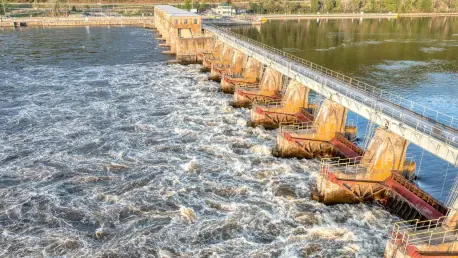As the Yarlung Zangbo River flows through the Tibet Plateau, China embarks on one of its most ambitious infrastructure projects to date, aiming to transform the natural landscape into a powerhouse of energy and progress. This undertaking involves building what is projected to be the world’s largest hydroelectric dam, commanding a stunning budget of $170 billion. Spearheaded by the Power Construction Corporation of China and China Yajiang Group, this colossal dam is expected to generate 300 billion kilowatt-hours of clean energy annually. To put this figure into perspective, it matches the entire electricity consumption in the United Kingdom. Scheduled to reach completion by the 2030s, the construction promises not only to light up millions of homes but also to fuel industries across the nation.
The Economic Impact and Investment Dimensions
A Boost for Industry and Infrastructure
The construction of this massive dam has set in motion a notable economic wave, boosting related industries such as dam-equipment manufacturing, cement supply, and construction services. As shares rise in these sectors, there is a tangible sense of optimism, albeit tempered with caution. From an investor’s viewpoint, hydropower projects present a notion of bond-like returns, offering stable, reliable income akin to long-term investments. Yet, financial analysts flag the risk of overinflated speculation as companies scramble to capitalize on the dam’s future potential. This economic boom invites consideration of how sustainable such growth could be, considering the balance between exuberant market reactions and grounded fiscal planning. It’s crucial to navigate this growth prudently to prevent an overshoot that may lead to volatility in the market.
Environmental Considerations and Challenges
Beyond its economic allure, the dam brings profound environmental challenges that merit extensive evaluation. Critics voice concerns about the ecological footprint of such large-scale infrastructure, particularly with the absence of comprehensive environmental impact studies. The region, marked by distinctive fault lines, raises questions around seismic safety, an issue of paramount importance when dealing with constructions this size. Calls for ecological conservation by Chinese officials, including Li Qiang, resonate in the backdrop, yet specifics are sparse. A rigorous analysis should precede construction decisions to safeguard surrounding ecosystems and ensure any adverse consequences are expertly mitigated. These environmental considerations frame a narrative that goes beyond mere construction, challenging stakeholders to consider longevity and ecological stewardship.
International Concerns and Water Security
Impact on Neighboring Regions
The Yarlung Zangbo River is a critical water source for regions like Arunachal Pradesh, Assam, and Bangladesh, making the construction of this dam an international concern. With neighboring areas relying extensively on the river for agriculture, fishing, and basic sustenance, changes in water flow could have significant repercussions. This potential disruption has led to official protests from India and raised diplomatic tensions centered around water security and resource allocation. The upstream intervention by China might alter the river’s course and affect downstream regions, holding potential for direct ecological and economic impacts on local communities. Coordinated efforts and dialogue with affected nations are imperative to address these issues responsibly.
Navigating Diplomatic Waters
As the dam project advances, China’s diplomatic relations with these neighboring states stand on pivotal ground and require nuanced navigation. Water security, an issue deeply intertwined with sovereignty and regional stability, necessitates transparent communication channels. While potential benefits are evident in terms of energy production, China’s approach should account for cross-border implications and ensure collaboration rather than contention. By establishing frameworks for mutual aid and shared resources, China can foster cooperation, paving the way for a dynamic yet harmonious regional development model. This diplomatic engagement can act as a cornerstone, balancing progress with empathy for those relying on the same natural resources.
The Path Ahead: Sustainable Development and Regional Cooperation
A Cross-Border Test for Future Policies
China’s endeavor signifies a formidable test in managing natural resources while considering both domestic and international concerns. As efforts unfold, the project offers a chance to forge new paradigms in cross-border relationships and sustainable development, exploring synergies that optimize resource potentials without undermining regional unity. The success of this venture hinges on an approach built around open dialogue, empathy, and a shared vision, allowing affected communities a significant role in shaping outcomes. This marks a critical crossroad for China to not only harness indigenous energy sources but to redefine collaborative prospects with neighboring nations.
Navigating Economic and Environmental Balance
The Yarlung Zangbo River serves as an essential water source for regions such as Arunachal Pradesh, Assam, and Bangladesh. This makes the construction of a dam on the river an issue with international implications. The surrounding areas heavily depend on the river for crucial activities like agriculture, fishing, and basic living needs. Therefore, any modifications in the water flow could have substantial impacts. Concerns about these potential disturbances have prompted official protests from India, intensifying diplomatic tensions over water security and resource distribution. China’s actions upstream may change the river’s course, posing a threat of direct ecological and economic effects on the communities that rely on it downstream. Consequently, it is crucial for affected nations to engage in coordinated efforts and dialogue to address and responsibly manage these challenges. Achieving a consensus through communication and cooperative strategies may help mitigate the adverse consequences for all parties involved.









